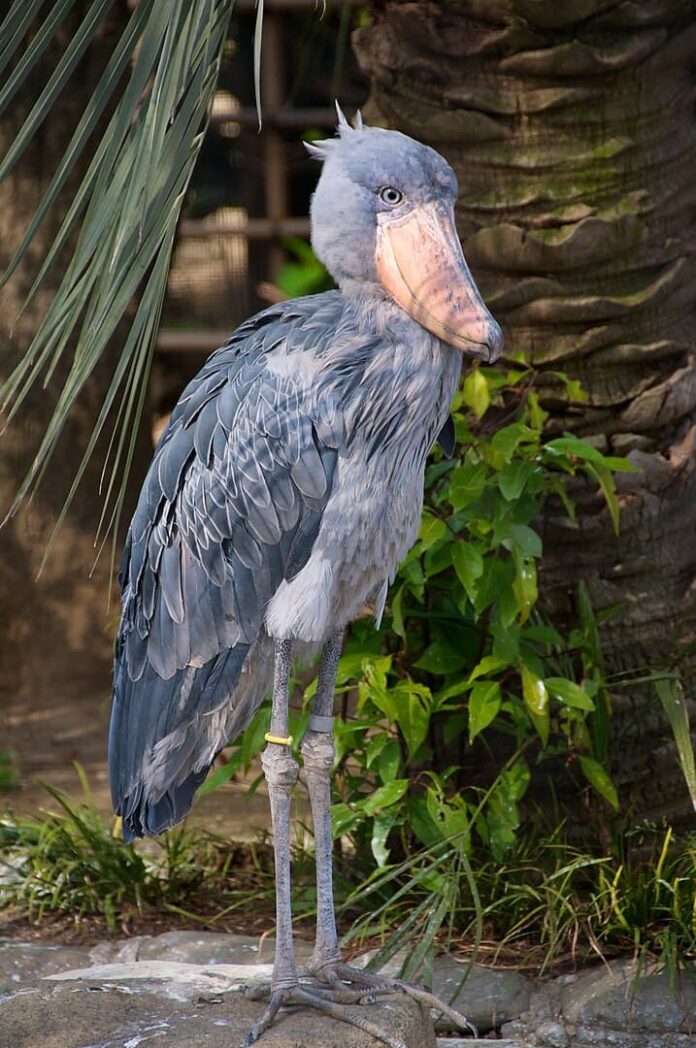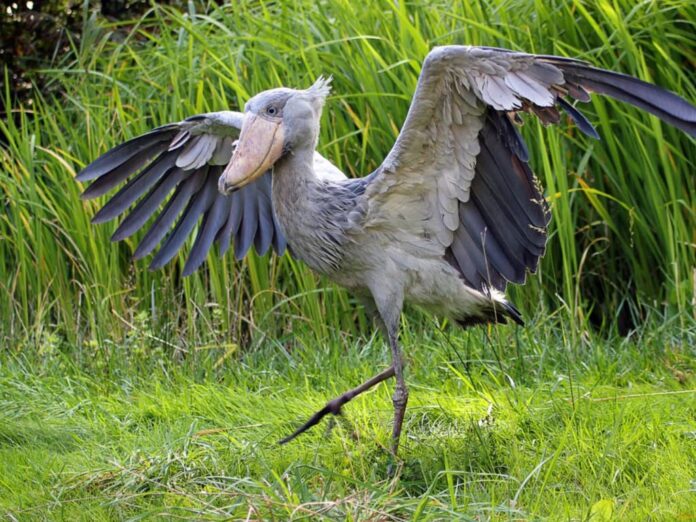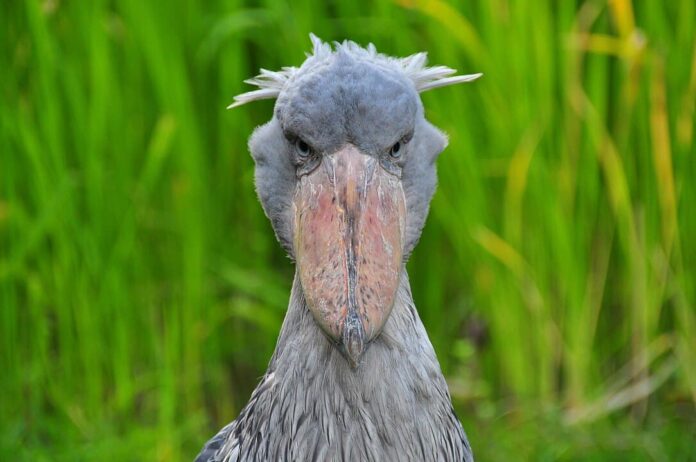Shoebill aka whale-headed stork has the look of somehow menace that makes you want to keep the distance. And this fact is more certain the moment it opens its bill to make a noise that sounds exactly like firing machine guns. I have always been fascinated about this bird, and we shall find out more about it below.
1Appearance

Shoebill is a large and tall wading bird with long legs that stands anywhere from 1.1 to 1.4 meters tall. There are also specimens that can be as tall as 1.52 meters, the same height as me. Along with that, its feet are also pretty large, with the middle toe reaching 16.8 to 18.5 centimeters. Also, their toes are completely divided with no webbing between them. As for the wings, they are broad and well-adapted to soaring, and they can be as long as 78 centimeters. These large birds have blue-gray plumage with darker slaty-gray flight feathers and white bellies. Shoebills have grayish-white or yellowish piercing eyes while some have exotic pale blue eyes that are absolutely striking. Those eyes and smirking-like bill look like they are planning something evil despite being a pretty chill bird.
As you can tell by the name, this prehistoric-looking bird has a shoe-shaped bill that resembles a Dutch clog shoe. The bill of a shoebill is large and bulbous, and it is straw-colored with erratic grayish markings. This bill is 18.8 to 24 centimeters long, and actually nearly as wide, and it is cavernous inside. It has a sharp edge and wide gape, and this bill allows the birds to hunt large prey when they need to. If we go into more detail, you can see that the upper mandible of the bill ends in a sharp nail. So even slippery prey cannot escape the seize once the bird strikes. Despite their intimidating appearance and sound, shoebills are quite docile with humans, and they show no threatening behavior at all.
2Behavior
Shoebills are normally silent but they do perform bill-clattering displays at the nest during the nesting season. These bill-clapping noise is to drive away interlopers, greet, and woo mates; males and females have different clapping tones. It is actually a means of communication, and this is why they also utter other noises, including cow-like moo and high-pitched whines. Shoebills are solitary, but they will come together when food is in short supply and during the breeding season. The monogamous breeding pair builds their nest together on floating vegetation and defends their territory aggressively. Females lay up to 3 eggs, and both parents feed, guard, and shade the chicks after they hatch. The thing is that the parents only raise one chick although there are more chicks hatching. As for the younger ones, they are left to die unless the eldest is weak or doesn’t survive.
3Feeding & Habitats

The large feet of shoebills give them the ability to stand on aquatic vegetation while hunting. Speaking of hunting, their method is striding very slowly and usually motionless; aka the “freeze and seize” strategy. They use their binocular vision to spot prey, and they launch a quick violent strike once they lock one in. Fish is their main and most favorite meal, and they like to feed on African lungfish, marbled lungfish, Senegal bichir, and tilapia. However, they also take on carrion, frogs, Nile monitors, rodents, small turtles, small water fowls, snails, and water snakes. And, of course, baby crocodiles are on the menu as well. As a diurnal bird, shoebill only hunts at night if the moonlight is bright enough.
Shoebills are endemic to central tropical Africa from South Sudan all the way to Zambia, inhabiting freshwater swamps and wetlands. These predators also live in seasonally flooded dense marshes and areas with grass beds and reeds in their range. They favor poorly oxygenated waters like bogs, marshes, and swamps where fish frequently surface to breathe and where lungfish and papyrus are abundant. This gives them a more successful hunting chance. Another interesting thing about them is that they have slow movements, and they tend to stay still for hours. That way, when a fish comes up for air, it will not notice that the predator has been standing there waiting.
4Threats
The current population of shoebills is between 5,000 to 8,000 individuals in the wild, and is declining. Most of which live in swamps in the Democratic Republic of Congo, South Sudan, Uganda, and Zambia. The number is very small these birds are classified as Vulnerable, and they are also facing many threats. Some of the main ones are disturbance, habitat destruction and degradation, habitat loss due to agricultural cultivation, hunting, and illegal capture. More than that, indigenous communities around their habitats capture their eggs and chicks for consumption and trade.
Related Post: Prehistoric-Looking Animals That Are Still Alive Today




